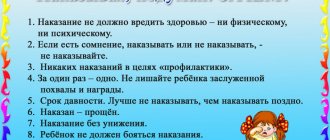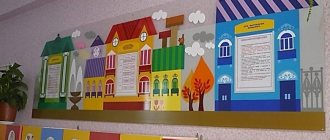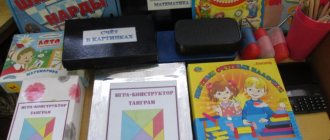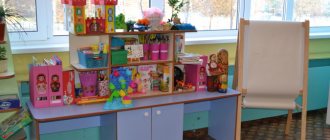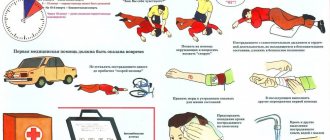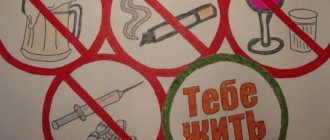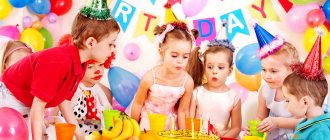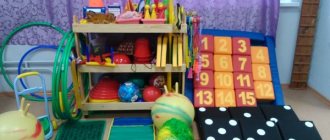Art Corner
To properly organize children's activities, zoning of space in the group room is provided. That is why you can find various themed corners such as “Kitchen”, “Hospital”, “School”, etc.
Some kindergarten teachers place the theater corner in a separate structure. However, more often we see large art centers where various subsystems are combined. They can combine a circle of drawing, music, manual labor and theater. This saves space. And most importantly, the basic principles of the theater corner are observed.
Requirements for a creative center
Since the theater corner in a kindergarten group is the most important element of the artistic and aesthetic development of children, it must comply with the following principles:
- The principle of mobility. It is necessary to provide for the possibility of combining different corners and zones of the kindergarten group, as well as the transportability of theater paraphernalia.
- The principle of material replacement. It is necessary to constantly update the repertoire, scripts, scenery and other paraphernalia. This will depend on many factors, for example, the time of year, the age of the children, their interest, software, topics of classes, etc.
- The principle of multifunctionality. It implies that the same attribute can perform multiple tasks.
- The principle of aesthetics. Theater should develop children's sense of taste.
- The principle of accessibility. The equipment of the theater corner should be suitable for children by age and coincide with their areas of current and immediate development.
Arrangement of the art center
Furniture for a theater corner in a kindergarten can be made independently from available materials, or it can be made to order. The main components of the theater are the screen and the mummers' corner. The rest of the attributes differ depending on the age of the children.
For example, for children of primary preschool age, props are used to stage fairy tales known to children (“Teremok”, “Turnip”, “Ryaba Hen”, etc.), namely: a flannelgraph for displaying pictures and a mini-screen for a tabletop theater. You can use simple costume elements such as a scarf, umbrella, beads or hat.
To equip the corner in the middle group, all kinds of masks are used. These can be animals, fairy-tale characters, and even images of vegetables. Paraphernalia used is a large screen for staging performances and a display case for costumes.
Children in the older group of kindergarten can use home-made decorations in productions. This increases children's interest in preparing the performance. It is recommended to have props available for staging 4-5 diverse fairy tales. This will give children a choice. They can also come up with their own fairy tales and performances based on these materials and decorations, thus developing creative thinking.
Organization of a corner of theatrical activities in a preschool educational institution
Organization of an object-spatial environment that supports theatrical activities
When constructing a subject-spatial environment that provides theatrical performance, the following are taken into account:
- characteristics of the child’s emotional personality,
- his individual socio-psychological characteristics;
- individual preferences and needs;
- curiosity, research interest and creativity;
- gender role features.
a theater zone should be equipped
or a corner of a fairy tale, as well as a “quiet corner” in which a child can be alone, look at illustrations for a work, and remember the content of his role. In order to realize individual interests, the subject-spatial environment must ensure the right and freedom of choice. Therefore, in the area of theatrical activity there should be presented different types of puppet theater, screens for display, masks, children's drawings, natural and waste materials, pieces of fabric for mumming.
The group rooms also have space for a theater corner
. The following materials are found here:
- tabletop theater;
- screen;
- sets of puppets (finger and flat figures, puppets) for acting out fairy tales;
- theater of mathematics;
- theater made by the children and teachers themselves (cones with nozzle heads, various masks, decorations);
- characters with different moods;
- material for making characters and decorations (colored paper, glue, waste material, pencils, paints, scissors and other materials);
- ready-made costumes, masks for acting out fairy tales, homemade costumes;
- substitute attributes (circles of different colors, stripes of different lengths) to designate magical objects and mark out the play space in kindergarten;
- mummering corner from the middle group (ready-made mummery);
- for older children - elements of mummery, wigs, etc.
Equipping a theater corner for the 1st junior group
- Attributes in accordance with the content of imitation and round dance games: masks-caps, figurative aprons, badges-emblems.
- For teacher games with children and surprise moments: “finger” theater (knitted the entire length of the child’s finger), cane puppets, dolls (images of people, animals), bibabo theater.
- To show children dramatizations of fairy tales (“Teremok”, “Turnip”, “Hen Ryaba”, “Zayushkina’s Hut”, “The Wolf and the Seven Little Goats”): a picture theater, a tabletop theater of plane toys.
- To create a musical background in the process of theatrical play activities: audio recordings of musical works, recordings of sound and noise effects, simple musical toys - rattles, tambourine, drum.
Equipping a theater corner for the younger group
- Carpet (flannelograph).
- Various types of theater: picture theater (“Three Bears”, “Kolobok”, “Hedgehog and the Bear”, “Hare and Geese”), parsley theater (“Who said meow?”, “Ryaba Hen”), shadow theater (“Fox and the hare"), a toy theater and a "finger" theater for performing works of small forms of folklore.
- Costumes, masks, theatrical and play attributes for acting out the fairy tales “Turnip”, “Ryaba Hen”, “Kolobok”, “Teremok”.
- Small screen for table theater.
- Attributes for mumming are elements of costumes (hats, scarves, skirts, bags, umbrellas, beads, etc.).
- Attributes in accordance with the content of imitation and round dancing games: masks of wild and domestic animals (adults and cubs), masks of fairy-tale characters
- To create a musical background in the process of theatrical play activities: audio recordings of musical works, recordings of sound and noise effects, simple musical toys - rattles, tambourine, drum.
For children from two to four years old
sets of ready-made toys or blanks and semi-finished products are needed for the manufacture of three-dimensional or planar characters and tabletop theater scenery elements. The figures can be small and medium in size, made of paper, cardboard, rubber, plastic, plastisols, papier-mâché, thin plywood. The image of theatrical toys is conventional.
For theatricality, carpet of a bluish or gray tone is used. Attached to it are sets of flat figures and decorations, also made of carpet or other materials secured with Velcro tape.
The theme of the kits is determined by the educational program.
For dramatization games, sets and elements of costumes, half masks of characters from familiar folk tales, made of paper, thin cardboard, papier-mâché, thinned or non-woven materials are required; characters from literary works or sets of characters for the bibabo theater, proportional to the hand of an adult (for showing to children) or a child (glove or finger), made of light materials (foam, papier-mâché on a frame), small and medium in size.
We also need figures whose heads are controlled by a cane, and whose arms (paws) are soft, expressive, and freely follow the movement of the body.
Equipment for a theater corner for the middle group
- Attributes in accordance with the content of imitation and round dance games: masks of wild and domestic animals (adults and cubs), masks of theatrical characters.
- Large folding screen, small screen for tabletop theater.
- Rack-hanger for suits.
- Costumes, masks, attributes for staging two or three fairy tales.
- Puppets and attributes for playing out the same fairy tales in various types of theater (plane on flannelgraph, rod, puppet, tabletop, glove).
- Attributes for "Colorful Tales".
- Theater of Mathematics.
- To create a musical background in the process of theatrical play activities: audio recordings of musical works, recordings of sound and noise effects, simple musical toys - rattles, tambourine, drum.
Equipping a theater corner for the senior group
- Theatrical and play equipment: large and small screens, fences, simple decorations made by children.
- Rack-hanger for suits.
- Costumes, masks, wigs, attributes for staging 4-5 fairy tales.
- The group has different types of puppet theater: picture theater, finger theater, glove theater, parsley theater, marionette theater, shadow theater of figures and masks, cane puppets, puppets with a living hand.
- For theatrical and play activities, there are technical teaching aids: audio recordings of musical works, recordings of sound and noise effects, video library of literary works.
For children four to six years old
t toys for theatrical games meet basically the same requirements as at the previous age stage. However, puppets with a basic control system are additionally recommended here; soft, on strong threads, commensurate with the child’s height.
Festive and carnival toys
For children under two years old
required:
- To participate in festive matinees and entertainment: carnival hats (bunnies, birds, kittens, bears, chickens and other characters).
- For festive decoration of the group and area - inflatable film balls (balls), funny figurative figures, flags and garlands of medium and large size. The materials for them can be paper, film, lightweight fabrics and non-woven materials.
Ready-made Christmas tree decorations for this group are selected from unbreakable, lightweight materials: multi-colored, small-sized balls, bells, snowflakes.
For children from two to four years old
In addition to carnival hats, you need ready-made half masks (bunny, bear, kitten, cockerel), made of paper, thin cardboard, papier-mâché (impregnated against fire).
Ready-made Christmas tree decorations can be different in shape, design, and material.
Semi-finished products are also needed for the manufacture of homemade Christmas tree decorations using film, paper, fabric (for flags, garlands), as well as natural materials (walnut shells, cones, acorns, branches, etc.).
Children from four to six years old
Large inflatable dolls, animal figures, fairy-tale characters, easy to carry, all kinds of wands, emblems may be offered.
Festive and carnival toys can be very large and decorative. Surprise toys with effects that imitate fireworks (without the use of fire or flammable materials) are interesting. The attributes of costumes and masks should be created in accordance with the anthropometric and ergonomic data of the children of each group.
The content of work on theatrical activities includes:
- watching puppet shows and talking about them;
- dramatization games;
- preparing and acting out various fairy tales, staging poems;
- exercises to develop expressiveness of performance (using verbal and non-verbal means of expressiveness);
- literary games “Guess the title”, “Guess the name of the hero”, “Remember and tell”.
I APPROVED
Head of MKDOU
d/s No. 347 “Ladushki”
_______N.V. Tretyakova
Regulations on holding a review competition
for the best theater center among preschool educational institutions groups.
1. Purpose of the competition:
creating optimal conditions for the development of a child’s creative activity in musical and theatrical activities.
2. Objectives of the competition:
2.1. To contribute to increasing the competence of teachers in creating conditions for the development of the child’s creative activity in musical and theatrical activities;
2.2. Create an atmosphere of creative search in the teaching staff for the effective organization of musical and theatrical activities;
2.3. Replenish the musical and theater center with attributes.
3. Participants of the competition:
Teachers and parents of all age groups of preschool educational institutions take part in the competition.
4. Date:
4.1. The competition is held from September 1, 2014 to October 30, 2014.
4.2. All music and theater centers should be prepared by OCTOBER 30, 2014.
4.3. Summing up the results of OCTOBER 30, 2014.
5. The competition is judged by a creative group consisting of:
• head of the preschool educational institution N.V. Tretyakova;
• senior teacher Aleksandrova S.L.; Goloskova Z.B.;
• educational psychologist Dudareva A.N.;
• musical director Basantsova G.N., Churkina D.V.
6. Criteria for evaluating musical and theater corners:
6.1.Requirements for registration:
- Aesthetics
- Availability
- Matching children's age and program requirements
6.2. Occupancy of the theater center:
- Variety of theater types and suitability for their age group;
- Availability of attributes and decoration elements;
- Availability and variety of costumes for theatrical activities;
- The presence of attributes, decorations, costume elements, etc., made in the joint activity of adults and children;
6.3. Originality of ideas;
6.4. Availability of card files (“Finger gymnastics”, “Physical education”, “Theatrical games and exercises”);
6.5. Availability of a music library of discs with recordings of children's songs, classical works, with a selection of background music for special moments;
6.6. Methodical piggy bank (lesson notes with elements of theatricalization, role-playing games, performances).
6.7. Availability of a variety of musical and didactic games according to the age of children; a variety of musical instruments (voiced and unvoiced).
6.8. The teacher’s ability to present his center.
7. Summing up and awarding the winners
:
7.1. The results will be summed up on October 30, 2014.
7.2. The winners who took 1st, 2nd, 3rd place are determined. The winners are awarded diplomas by the pedagogical council.
7.3. The most active parents are awarded diplomas at the parent group meeting.
Types of representations
The theater corner in kindergarten involves not only learning the script and staging a performance. There are many types of performances in which children will develop not only imagination and creative thinking, but also fine motor skills, associations and even tactile sensitivity.
In kindergarten, the theater corner, as a rule, consists of several blocks. When forming them, you need to take into account the age factor. An art center may include the following types of theater:
- Finger.
- Desktop.
- Theater toys: soft, knitted, cone, etc.
- Puppet.
- Parsley Theater.
- Theater of Transformation.
Performances using puppets are especially varied. Props can be:
- Puppets.
- Dolls with a “living” hand.
- Mitten gloves.
- Doll people.
- Homemade products on a thread or elastic band.
- Cane puppets.
It is recommended to alternate between different types of creative activities so as not to cause satiety in children.
DIY puppet theater
To create a theater you will need a box with sides up to 10 cm high. A cookie box will do. We cover the box with colored paper using double-sided tape.
Let's start creating the curtain. The width of the curtain can be from 3 to 5 cm, the length is the size of the box. On a sheet of red velvet paper, measure the width of the curtain twice and cut off a strip. Then fold it in half, draw the outline of the curtains and cut it out. We cut the finished part along the central fold. We draw folds that imitate the drapery of a curtain with a felt-tip pen. Glue the curtain along the edges of the box.
Then we make a lambrequin. Measure 2 cm in width, draw an outline and cut it out. We measure the length of the lambrequin using the box. We cut it out, draw draperies, and glue it on top of the curtain.
Using a stationery knife, we make a slit up to 1 cm wide on the side of the box, through which the decorations will change.
Backdrops for decorations can be printed or drawn by hand. The size of the pictures must be adjusted to the internal size of the box. If the backgrounds are composed during the course of a fairy tale or play, their change will create the impression of a real theatrical action.
To make the characters you will need juice straws, double-sided tape and printed images of the characters. We fix the cut out figures on the tubes. All is ready! The show can begin.
Material for decoration
To create a theater corner in a kindergarten with your own hands, any available means are suitable. Most often used:
- milk cartons and other tetrapacks;
- carton boxes;
- plastic bottles;
- kinder surprises;
- gloves, mittens;
- shawls, stoles, scarves, scarves;
- wool threads;
- papier mache;
- scraps of unnecessary fabric;
- paper and cardboard;
- disposable tableware;
- cans;
- cup holders;
- socks and unnecessary clothing;
- foam rubber and polystyrene;
- wooden spoons;
- salty dough;
- natural materials, etc.
Any item can be adapted for decoration. However, the main thing is to take precautions. The paraphernalia that the child will constantly use in his theatrical activities must be safe.
Non-traditional types of theater
In addition to the usual materials for puppet theaters, alternative types can be used.
These can include plastic and wooden spoons. Images of characters are drawn or attached to them. When painting on plastic, you should use acrylic paint. If you have to paint with gouache, it is mixed with a small amount of PVA glue.
Interesting options are made from yogurt jars and plastic bottles. They are covered with colored paper, images of characters are attached and fragments of scenery are added. The results are voluminous mini-stories. Such figures do not require additional decorations and develop children's imagination.
Playing theater is a useful and interesting activity. It improves memory and develops oratory skills. The child learns to retell the text, highlight the main points, not be afraid of public speaking, and parents have the opportunity to discern the child’s talents.
Decorating ideas
In the design of a theater corner in a kindergarten, the so-called barker doll plays a key role. This is a kind of talisman and guardian of the theater. This item can be any character from a fairy tale. It can even be fictitious, the main thing is that it is always in a visible place. It is desirable that this attribute of the theater is always in the theater corner and occupies a central position. It’s even better if he takes part in productions or acts as a spectator.
How to design a theater corner in a kindergarten? This question is asked by all beginning educators. Initially, it is necessary to make a screen, both large and small, for the tabletop theater. For this you can use any light fabric. Just hang it on a stick or baguette and secure it to a tripod. You can also use a wooden frame.
Window screens are very popular. They are universal, they can be used for both large and tabletop theaters. To make them, you need to take a sheet of thick cardboard and cut a window in it. You need to hang the curtain in the hole, and the screen is ready.
The example of decorating a theater corner in a kindergarten in the photo below shows that, with a lot of imagination, you can create a colorful and interesting “temple of Melpomene.”
Shadow play. How to do it quickly and easily
Step 1. Setting the stage
Take a medium sized box. Preferably 10-15 cm wide, but a box of a different width will do. You will need a ruler, pencil, stapler, scissors. We separate the box from one long side. You should get a large rectangle, one plane of which is flat without bends. ON this side we measure 5 cm from the edge. Draw the frame of the screen and cut it out. We fasten it with a stapler at the corners so that we get an L-shaped structure with a vertical future screen. Cut off the excess.
We measure out the paper that will cover the screen with an allowance for gluing. The top of the screen can be secured with a stapler. Apply paper glue to the remaining sides.
Step 2. Create characters
You will need a pencil, cardboard, scissors, a stapler, and straws for drinks. We draw characters and cut them out. In addition to action heroes, you can make the sun and clouds, birds and trees, houses and castles. Using a stapler, we attach the figures to the straw.
Step 3. Play the play
We learn a fairy tale, install a table lamp behind the screen, and play the fairy tale. Don't forget about sound effects.
Theater and Music Center
Quite often you can find combined corners. Artistic performances have musical accompaniment. For this purpose, various tools and technical devices are provided in the theater corner.
Wooden spoons, rattles, maracas, whistles, etc. are used as factory and homemade instruments. A theater and music corner in a kindergarten can also contain noise jars (Kinder Surprise containers with various fillings), hammers made from corks, pancakes made from saw cuts, metallophones, tambourines, bells, accordions, guitars, etc. All these devices can be used to create your own soundtrack or play existing compositions. This develops a sense of rhythm in children and instills a love of music.
In older kindergarten groups, tape recorders are used to listen to music, record sound and noise effects, and watch a video library of literary works. Children in preparatory groups act out scenes accompanied by ready-made sound accompaniments, for example, audio fairy tales.
Contents of work on theatrical activities
The activities of the creative corner should have a clear focus. Therefore, you cannot simply leave children’s staged games to chance. It is necessary to constantly monitor the process of theatrical activity.
For this purpose, they watch puppet shows and conduct discussions on them, organize dramatization games, literary competitions “Guess the title”, “Guess the name of the hero”, “Remember and tell”. They act out fairy tales and stage performances based on poems. Also, be sure to perform exercises to develop expressiveness of performance.
